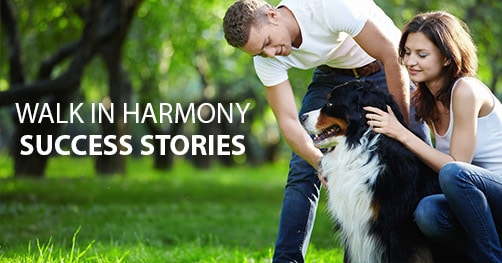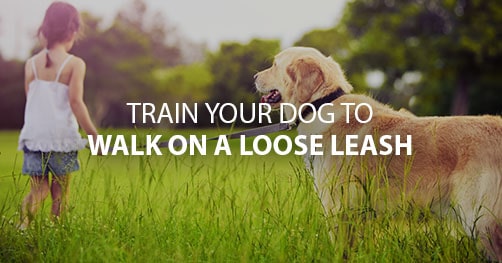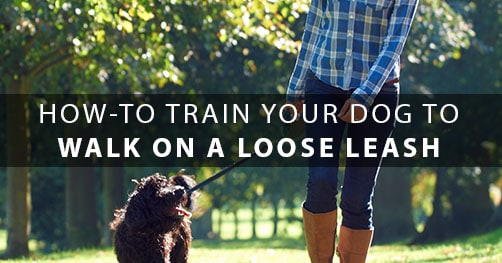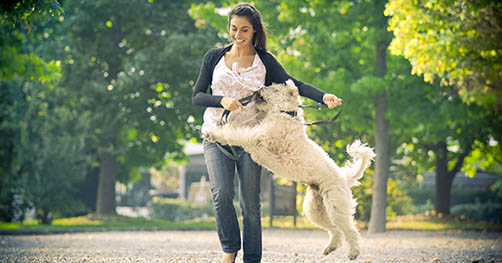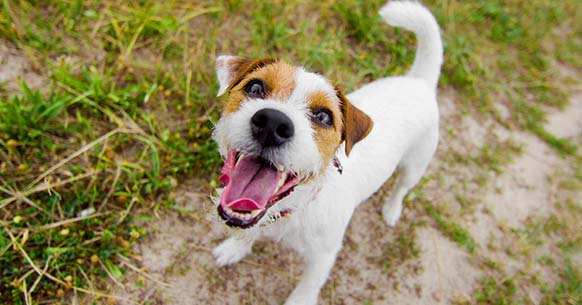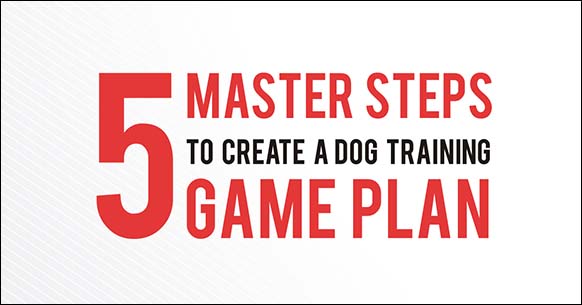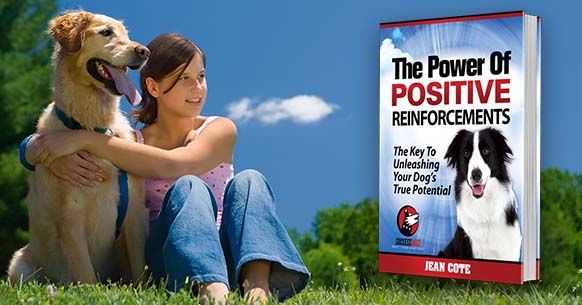Success Stories: How Our Students Are Training Their Dog To Walk On A Loose Leash (And Stop Pulling On The Leash)
In my first article in this series on training your dog to walk on a loose leash without pulling, I shared my unique four-step training process. In my second article I discussed the five most important reasons you should train your dog to walk on a loose leash.
In this article I will share some of my students’ success stories. You’ll see that it’s possible to transform your dog’s walking behavior, no matter your circumstances. And by the end of the article you’ll be motivated to take action yourself. If others can do it, so can you.
I would like you to meet two dogs, Balto and Makita, belonging to one of my students.
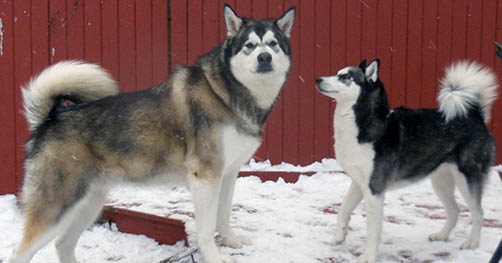
Balto and Makita are large dogs that weigh over one hundred pounds each. Their owner, Luann, was having a difficult time walking them together because they were easily distracted. But with the help of the self-control training games inside my Walk In Harmony Game Plan, Luann was able to teach her dogs to focus on her.
Here is what Luann said after completing my program:
[order_box style=”4″ alignment=”center”]“Because of the Walk in Harmony Game Plan, I can finally walk both of my dogs at the same time and go to parks, beaches and even hiking with them. I have a 3 year old small Siberian Husky and 7 month old 100 pound Alaskan Malamute and they both are natural pullers when walking on a leash. I had to take them on walks separately because of the pulling and being distracted so I only took them one at a time up and down my block. After using this program on both dogs I can now take them on walks together and go to parks and beaches, hiking and anywhere I want.
This program is a fun-filled positive, motivating, and bonding program for both owner and their dog. The Walk In Harmony Game Plan is user friendly, day by day steps which makes it easy to understand, and very precise easy to follow videos.”
[/order_box]Building your dog’s self-control is vital. It will teach your dog to think twice before running after something like a squirrel or another dog. And the best thing is that you can start building your dog’s self-control in only five minutes and in the comfort of your own home.
For example, my popcorn training game teaches your dog to ignore a pile of popcorn on the ground. Although you’re not likely to see this while walking your dog, the purpose of the training game is to build your dog’s tolerance for distractions by focusing on you instead of the distraction. The game serves as a blueprint you can use to train your dog to overcome any distractions including a dog barking, a squirrel running, or something on the ground.
If you haven’t yet tried my popcorn training game, here is a sample video showing exactly what to do:
Meet another student who has gone through my Walk In Harmony Game Plan: Lisa also struggled because her dog Doodle was easily distracted. But her dog reacted differently than Luann’s. Instead of just pulling on the leash, Lisa’s dog would also become overly excited and bark uncontrollably at the distractions. Lisa found herself in a quandary: How could she get her dog to stop barking?
Like Luann, Lisa also found the self-control training games to be extremely beneficial. Here is what she wrote to me after completing the program:
[order_box style=”4″ alignment=”center”]“My dog is a 9 month old Doodle who was very easily distracted by birds, cats, other dogs and especially squirrels. The walk was a constant struggle because he would zone out at the sight of any of these. He would become extremely excited, pulling and barking and then remain in that state of excitement for the rest of the walk. We had an AHA moment where I understood how to apply the ‘ It your choice’ principal to the beginning of the walk.”
“Some days we don’t walk at all we just practice going back and forth up the driveway working on self-control and paying attention to me. This has greatly improved our walk. He is much better when passing dogs now. He still gets really excited with squirrels but he seems to recover from them a little quicker so that I get his attention back. He is still a work in progress and we have a ways to go yet but I feel more confident now with the tools I learned from Jean’s program. I have always used positive reinforcement when training Doby but the addition of the ‘it’s your choice’ component has made a huge difference.”
[/order_box]If you’re wondering what Lisa means by “It’s Your Choice,” it’s the process of teaching your dog that it has a choice. Instead of punishing your dog for bad behaviors like pulling on the leash or barking, I teach my students to offer their dogs a choice. If their dog makes the right choice, such as paying attention to them, walking next to them, or ignoring distractions, then they reward it.
This is the opposite of what many traditional dog trainers teach. Many dog trainers will have you punish your dog for bad behaviors by either pulling sharply on the leash or using a pain-inflicting device like a choke or prong collar.
There’s none of that in my program. Instead, my program requires you to think creatively and to understand what goes on in your dog’s mind. As you offer your dog choices, your dog will learn to think about what it’s doing, and over time your dog will learn to look for ways to please you, even when you’re not actively asking it to do anything.
That is how I teach my students to train their dogs, and that ultimately leads to the happy, well-behaved family dog they’re proud of.
Now I’d like you to meet Chester, another dog that has gone through my Walk In Harmony Game Plan with her owner Marianne.
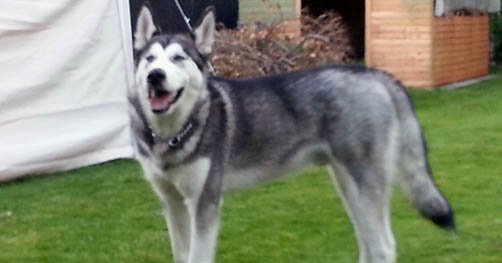
Marianne knows a thing or two about dogs and is very experienced with owning different breeds. But before she enrolled in my program she had trained her dogs using the traditional methods I mentioned above that are focused on punishments instead of rewards.
But Marianne was looking for a better way to train her dog to walk on a loose leash. She wanted her dog to pay attention to her, to walk at the same pace with her, and to respond to her body language.
Here’s an excerpt from a letter she wrote me after going through my Walk In Harmony Game Plan:
[order_box style=”4″ alignment=”center”]“Jean Cote’s Walk In Harmony Game Plan was certainly one of the BEST investments I have paid for – no classes, no fuel costs and no ‘waiting’ around to ‘do my turn’!
Jean Cote has changed my perspective on training and I am much more realistic in my expectations. Having had MANY dogs including Boxers, and bred Westies I thought I had done pretty well. Jean Cote has given me a much faster and patient methodology in training and with my latest (18 months at start of training) Chester – a Husky cross Alaskan Malamute, weighing now 6 stone+, it has been so rewarding for both of us in learning to ‘talk’ and ‘respond’ to each other – particularly as Chester is my ‘soul mate’ and just wants to ‘be’ with me and please me!”
[/order_box]I will be honest and say that her letter left me a little teary-eyed. There’s nothing better than making a difference in my students’ lives and seeing how much their relationships with their dogs blossom as a result of my training methods.
That is why I’m so passionate about this subject. It’s not just about training your dog to walk on a loose leash or to stop pulling. My ultimate goal is to give my students the tools and strategies to train their dogs to do anything they want them to do.
I believe the more time you spend interacting, training, and having fun with your dog, the less likely you are to give up your dog. There’s a crazy statistic from the ASPCA that 3.9 million dogs in the United States are abandoned to shelters every year. And of that number, 30 percent will be euthanized.
That is a staggering statistic, and it’s only for the United States. And so it’s my duty as a professional dog trainer to promote these training methods because I know how much they can improve the quality of life for both owners and their dogs.
I would like to thank you for reading this three-part series, and if you would like to continue your education I would be pleased to welcome you inside my “Walk In Harmony Game Plan.” I’m always excited to meet and greet new students, and I look forward to reading your success story.
Five Good Reasons You Should Train Your Dog to Walk on a Loose Leash
In the first article of this series, I shared my steps for training your dog to walk on a loose leash and stop pulling once and for all.
For some reason, whenever I discuss these training steps with my students, they always want more information. They want more details—almost like they’re looking for that secret piece of the puzzle that will magically transform their pets into perfect walking dogs.
However, the sad truth is that there’s no such thing. Nothing replaces hard work, and if you want a dog that walks on a loose leash, then you will have to take the time to train your dog.
I will admit that most people don’t find this proposition attractive. They think to themselves, You mean I have to train my dog? That’s way too much work!
Yes, that is exactly what I’m asking, but you don’t have to take any extra time out of your day. All you have to do is replace the time you’re already taking to walk your dog and replace it with the time you use to train your dog. Simple, right?
I wish all dog owners did this with their dogs. Unfortunately, even after I’ve laid out my logical case, most people still won’t take the time to train their dogs to walk on a loose leash. It requires effort, dedication, and energy.
So in this article, I’m going to share with you five good reasons you should train your dog to walk on a loose leash (and to stop pulling). These reasons are meant to energize and motivate you to take action and begin training your dog.
Reason 1—The longer you wait, the more your dog will pull on the leash.
It’s no secret that many dog owners will tolerate their dogs’ habit of pulling them. Many think it’s a normal part of owning a dog, whereas others simply don’t know what to do or how to solve the problem.
Either way, the longer a dog gets away with pulling on the leash, the harder it’s going to be to curb this habit, which is caused by self-rewarding behaviors—which is explained in detail in the first article of this series.
This is why training a puppy is so much easier than training a full-grown dog. A puppy has not yet developed the bad habits of walking ahead and pulling on the leash. You can get a puppy to walk nicely beside you in just a few training sessions.
Now, that’s not to say you can’t train an older dog who has been pulling for months or even years. You definitely can do it. However, it will be more challenging because you will need to replace the old habits of walking ahead and pulling with new ones such as walking by your side and paying attention to you.
Reason 2—Pulling is a serious safety issue.
Walking a dog that constantly pulls on the leash is not a pleasant experience, and in some cases, the dog pulls so hard that it causes physical pain in the owner’s hand, wrist, arm, or shoulder.
I recently had a student enroll in my Walk in Harmony Game Plan who had had an incident with her dog and needed surgery on her shoulder. She was walking her dog when, all of a sudden, her dog saw a squirrel and decided to run after it, putting massive strain on her shoulder.
Another student of mine suffered from a broken wrist because her dog was pulling on its leash during a winter snowstorm. She didn’t realize that her dog was pulling her toward an icy patch, and she ended up slipping and having to go to the hospital.
I even had another student tell me a story about when she almost got hit by a car because her dog decided to pull her toward a busy intersection. She was walking a big German shepherd, and had she not dropped to the ground to make her dog carry all of her weight, both she and her dog would have been hit by a car.
Now, these cases might seem extreme, but they are real stories from ordinary dog owners who never took the time to train their dogs to walk on a loose leash. They were just too busy with life, and their dogs’ tendency to pull them wasn’t a big enough problem.
My advice is to not wait until it’s too late before doing something about your dog’s pulling behavior. I know that prevention isn’t easy, but if it can prevent an injury, it’s time well spent, in my opinion.
Reason 3—Pulling on the leash often leads to less exercise.
Did you know that humans will do more to avoid pain than they will do to gain pleasure?
This simple fact is also at play for dog owners training their dogs to walk. For example, if your dog is constantly pulling and dragging you around the block, you will experience physical discomfort from a sore hand, wrist, arm, or shoulder.
On top of that, there’s also the emotional pain of what others will think of you. Often, people will make the assumption that you’re a bad dog owner simply because your dog is pulling you on the leash.
I had a student in my Walk in Harmony Game Plan tell me how her neighbor told her silly things as she walked her dog such as “You should have a sled,” “It’s a good thing you don’t have a big dog,” and “Your dog is sure leading the way!”
Of course, her neighbor was just trying to be funny and didn’t intend for those comments to be hurtful. But sometimes what others say can influence us more than we realize, and we can easily associate physical and emotional pain with walking our dogs, which leads us to unconsciously walk them for shorter distances and less frequently.
Another student of mine presents a perfect case of this. She was so ashamed of what other people thought of her while she walked her dog that she would only walk her dog late at night or early in the morning when it was still dark so that nobody could see her getting dragged down the road.
The overall problem is that dogs need lots of daily exercise to release their excess energy, and if you end up walking your dog for shorter distances and less frequently, it will be getting less exercise. If your dog doesn’t have an outlet for excess energy, it will find another way to get rid of it, even if that means doing destructive things such as barking, digging, and chewing.
My sister had this exact problem with her dog a few years ago. Her dog was constantly chewing shoes and furniture. All of that stopped when she started walking her dog for an hour twice per day—her dog simply wasn’t getting enough exercise.
Reason 4—Be able to go anywhere with your dog.
Wouldn’t it be great if you could go anywhere with your dog? This is why I’m so passionate about loose leash training. I want dog owners to be able to go to the park, attend public events, hike, jog, or even take a trip to their local pet store with their dogs. Why should anyone be restricted to just going around the block?
Not only are longer walks beneficial to your dog’s health and well-being, but they’re also great for getting rid of stress. So many of my students live hectic lives with busy schedules, and they tend to be exhausted when they come home at night. The problem is that walking their dogs becomes a chore rather than a way to relax and be out in nature with their dogs.
That’s why taking the time to train your dog to walk on a loose leash is so important. Once you’ve trained your dog, you can go wherever you want, whenever you want. Walks are no longer stressful situations.
Reason 5—Training transforms your dog into a happier, better-behaved family pet.
When I ask my students why they decided to get dogs, they usually tell me it’s because they thought getting a dog would bring happiness to their lives, that their dogs would cheer them up when they felt alone or sad, or that having a dog would give them a reason to get out of the house. But these reasons somehow get forgotten over time, and the struggles of owning a dog become the main focus.
I’ll admit that it’s important to address any behavioral problems that come up with your dog; however, it’s just as important to remember why you’re doing all of this in the first place. Focusing on the problem doesn’t solve it. Focusing on the solution does.
What will motivate you to seek the solution is the vision of why you wanted to get your dog in the first place: the moments you imagined sharing with your dog and the positive things you thought it would bring to your life. If you can get through the tough times, even when it seems like there’s no hope for you or your dog, your relationship will grow stronger. It’s kind of like a couple getting through a rough time. Maybe it’s someone getting laid off at work or a death in the family. It’s extremely difficult during those times; however, once they’ve passed, the couple can look back on them and smile because those events made them stronger.
The same is true with training your dog to walk on a loose leash. It may seem hopeless right now, but it can be the time when you learn how to properly train your dog by using positive reinforcement. If you take the time to master these training techniques now, you’ll not only get a dog that walks on a loose leash but also one that wants to please you in the future. Because the training methods I share in my Walk in Harmony Game Plan are widely applicable, you can use them to get your dog to do almost anything.
Many of my students continue to train their dogs beyond the scope of the program. They’ll use what they learned to teach their dogs to do tricks and all sorts of other neat stuff.
PART 3:
In the final part on this series on training your dog to walk on a loose leash, I’m going to share some real-life success stories of how my students used my Walk in Harmony Game Plan to get their dogs to walk on a loose leash and how you can do it too. Stay tuned.
The Ultimate Guide on How to Train Your Dog to Walk on a Loose Leash
Is your dog pulling you on the leash? If so, then you’ve come to the right place. In this training guide, I’m going to share with you four training steps to getting your dog to walk nicely on a loose leash with you and to stop pulling once and for all.
Now, before we dive into the actual training, I’d like you to meet Sophie.
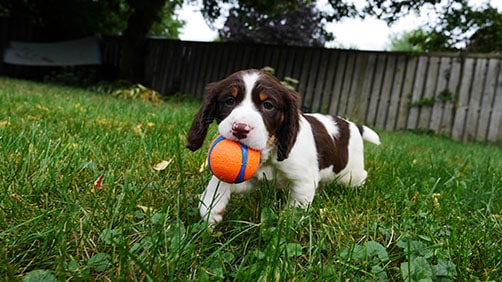
This is a picture of Sophie on the very first day I met her. You see, I met Sophie because my friend was having an extremely difficult time walking her. She would pull on the leash, bite the leash, tug on the leash, lunge at anything that moved, jump up, and bite clothes and shoes.
Does any of this sound familiar?
Although your dog’s pulling behavior might not be as bad as Sophie’s was, I want to share with you exactly what I did to train Sophie. This way, you’ll get a real-life example of how my training methods can be applied and get some insight into how to use them with your own dog.
The sad truth is that there are many ways of training a dog. And though all training methods do work in their own ways, I’m what you could call a gentle soul and have a strong belief that inflicting physical pain on a dog during training is unacceptable.
That is my own personal belief, and it has forced me to think “outside the box,” so to speak, and train using a different method—with positive reinforcements (or force-free, as some would say).
Okay, let’s get started!
TRAINING STEP #1: Eliminate Self-Rewarding Behaviors
Before I give you training advice on what to do, it’s really important that you first understand WHY your dog is pulling on the leash in the first place.
Pulling on the leash is not a natural behavior that your dog is born with. Why would a dog want to strangle himself to the point of gasping for air?
The main reason a dog pulls on the leash is because it’s a reinforced behavior. Yep, in one way or another, your dog is being rewarded for pulling (I’ll explain how below), and most dog owners aren’t even aware of it.
Let me give you an example.
John decides to take his dog to the park for a game of fetch. He knows how much his dog loves this game, plus it’s good for his dog’s health and well-being. So they start walking, and his dog pulls and drags him all the way to the park. They then proceed to play fetch for ten minutes.
This might be a pretty obvious example, but the act of playing fetch (which is something his dog loves more than anything else) will reward any behavior that occurred before, including the pulling.
If you look at it from the dog’s point of view, why wouldn’t he pull? The faster he gets to the park, the faster he will be able to play fetch. And if his owner isn’t aware of what’s happening and how this is rewarding his dog for pulling, the behavior of pulling will get worse over time.
Imagine that this scenario is repeated daily for months. This is how pulling becomes a big problem, and if nothing is done, John will end up with a sore shoulder and wrist and begin to resent walking his dog.
Here’s how you can stop this downward spiral dead in its tracks:
Whenever your dog pulls on the leash, especially if your dog is trying to get to or at something, stop walking and wait for the leash to loosen. An even bigger deterrent is to turn around altogether and walk in the opposite direction.
What does this do? Remember, your dog is pulling to get to something more quickly, and stopping, walking, or turning around creates an incentive to keep the leash loose.
This is exactly what I did with Sophie (which you can see inside my Walk in Harmony Game Plan).
Sophie would pull because she wanted to go to the park and sniff the grass. She would pull when she wanted to meet another dog or stranger or whenever there was an object on the floor she wanted to sniff and investigate.
I had to teach her that pulling would delay the time before she could get to those things. And it worked!
You can do it too. All you have to do is commit to practicing this simple exercise with your dog for the next week or month. Now, before you go ahead and try this exercise, you first have to take into consideration how long your dog has been pulling.
If your dog has been pulling for months or even years, then it’s going to take considerably longer to undo this conditioning. Pulling is like a bad habit, and habits are hard to break. It simply takes time, dedication, and consistency.
TRAINING STEP #2: Reward the Behaviors You Want
The second biggest factor that will influence your dog’s walking behavior is whether you are rewarding your dog for walking nicely with you.
You would be surprised by how many dog owners I’ve worked with who don’t actively do this. And I don’t blame them; our society has programmed us to adopt a punishment mind-set. We are used to looking for ways to punish or suppress bad behaviors.
Here’s a personal example. In one of my relationships, my girlfriend really wanted me to call her every single night. If I missed just one phone call, however, she would become angry with me and let me have it the next time I called her. She wanted me to call more often, but her approach was to punish me for not calling, so when I did call, I received lots of pain.
What do you think ended up happening? You guessed it—the frequency of my phone calls lowered until one day our relationship ended.
Traffic tickets are another example. We all know that speeding is bad and we shouldn’t do it. But let’s be honest—the real reason we don’t speed is because we don’t want to get a speeding ticket. We don’t want the burden of dealing with a police officer and having to pay the fine. And a speeding ticket will usually drive up the cost of car insurance.
Most of us want to avoid the consequences of speeding.
But what if we flipped the psychology, and instead of punishing the “bad” behavior, we rewarded the “good” behaviors?
What if a cop pulled you over and handed you $50 for driving the speed limit? Would you be more or less likely to drive the speed limit in the future? My guess is that you would be more likely to do so.
Of course, this wouldn’t be practical because it would cost a fortune. Luckily, there aren’t any limits on the amount of positive reinforcement you can give your dog. You can easily reach down and give your dog a pat on the back while saying “good dog!” for walking nicely at your side.
And here’s the kicker: the more often you reward your dog, the more your dog will want to walk nicely with you. The behavior will grow over time.
This is exactly how casinos work. A casino never forces anyone to play a slot machine, but if you walk into any casino, you will find someone playing—and most likely losing money.
How do casinos do it?
It’s simple! The casino rewards the player for playing! Everyone who walks into a casino has the dream of walking out rich, of making an extra $10,000 or even $1,000,000. That rarely happens, though. What casinos do instead is give smaller rewards randomly.
Imagine you are on your tenth play and all of a sudden your slot machine starts making noise, the siren goes off, and your machine rack up points for two entire minutes. Everyone around you smiles and congratulates you on your big win. You’re now just a little bit ahead.
And what do you do? You guessed it—you keep on playing in hopes of getting an even bigger prize.
This is exactly how you want to think when training your dog. You want your rewards to build the behavior of walking nicely with you. And it’s extremely simple to do, as I show in my Walk in Harmony Game Plan.
First, you will need to make a list of the behaviors you want to reinforce. These might include walking at your side, looking up at you, stopping when you stop walking, keeping up the same pace as you, ignoring objects on the ground, ignoring other dogs, etc.
Then simply give your dog a reward for engaging in those behaviors. The reward can be anything: saying “good dog” in a cheerful and happy tone of voice, touching and patting your dog, stopping and playing a quick game of tug, or giving your dog a delicious treat.
The key is to give the reward immediately after the behavior so your dog makes the association between his behavior and the reward.
TRAINING STEP #3: Focus on Progress Instead of Perfection
I wish I could tell you that you can get your dog to stop pulling in one afternoon. It would make a great marketing sound bite. The reality, however, is that it’s probably going to take longer than that. It really depends on how long your dog has been pulling.
For example, a dog that has been pulling on the leash for five years has developed a habit that will be harder to break than the habit of a young puppy that is just learning the rules of walking.
But no matter how long your dog has been pulling, you can change the behavior. The key is to focus on progress instead of perfection.
What you want to do is to focus on improving your dog’s current behavior. If your dog can only walk four steps before pulling on the leash, your goal should be to get your dog to take five steps without pulling.
Your goal should be to ask “a little bit more” from your dog each time you go out for a walk.
This is how professional dog trainers train dogs: they focus on the next achievable step. And this is exactly what I did with Sophie. I didn’t show up one day and have one training session, and then she was magically transformed into a Lassie. It took many training sessions with a focus on improving her walking behavior a little bit each day.
In fact, I kept a written journal of every training session I had with her, and I would highly recommend that you do the same.
Here is what it looks like:
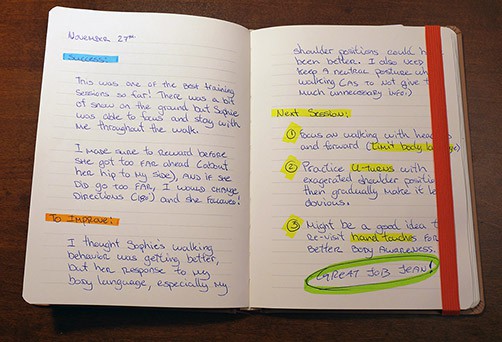
It’s very simple. All you have to do is write three things:
- What went well during the training session (or walk). I’m a firm believer in celebrating successes no matter how small they are. This acknowledgement is also going to give you the emotional juice to keep going.
- What didn’t go well during the training session (or walk). This will be really easy to remember, but I still urge you to write it down. Why? If you write it down, you won’t have to remember it. It’s like Einstein said: “Paper is to write things down that we need to remember. Our brains are used to think.”
- What you need to work on in the next training session (or walk). This is the most important thing to write down, so try to do it immediately after your training session (or walk). Doing so will make your brain think about a solution rather than dwelling on the problem.
And if you are a more advanced trainer, you may even want to videotape your training sessions. That way, you can review the footage and even ask for advice on possible training solutions. For the vast majority of dog owners, though, this isn’t practical or necessary.
All you need is a simple notebook to use as a training journal.
This is why my Walk in Harmony Game Plan is so effective: because I went through this process with Sophie and kept a written record of every one of my training sessions with her. I could open up my training journal right now and tell you exactly what I did during each training session.
TRAINING STEP #4: Play Training Games to Strengthen Skills
Did you know you can improve your dog’s walking behavior without ever leaving the house? Yep, all you have to do is work on teaching your dog the following five skills:
- Attention
- Self-control
- Obedience
- Loose leash manners
- Body awareness
What are these skills?
They are skills that you can teach inside your home where there are no distractions, and then once your dog has mastered them, you can utilize them outside to make walking your dog easier.
For example, you can teach your dog to look up at your face. How useful would this be? Well, next time you are walking past a distraction, you can say “look at me,” and your dog will look at you instead.
Or how about teaching your dog to control his instinct and not lunge or pull toward things on the ground? This is exactly what happens when you strengthen this skill.
So how does it work?
Simple. All you have to do is set aside ten to fifteen minutes a day and teach your dog a particular skill.
I lay out all of my skill-building training games in my Walk in Harmony Game Plan, but here is one I played with Sophie. The objective was to teach her to ignore a pile of popcorn on the ground.
(Click the play button below to watch the video.)
As you can see from the video above, Sophie was quite persistent in the beginning. By the end of the training session, however, she had much better self-control. Imagine if you worked on this every day for a week or a month how much better your dog would be!
PART 2:
In the second article of this series, I’m going to share five reasons why you should train your dog to walk on a loose leash (and to stop pulling) that are incredibly important. As a loving pet parent, you absolutely need to be aware of them. Click here to read part two.
How To Stop A Dog From Jumping Up
Jumping is a problem that a lot of pet parents deal with. Dogs jump for a couple of reasons. One reason is because the dog is excited. Another reason is because the behavior has a reinforcement history. And one other reason is because our faces omit a lot of smells and the dog wants to get a good whiff.
Stopping Your Dog From Jumping on You:
A lot of people get home after a long day of work and get jumped on when they walk through the door. If this is a problem to you, how I recommend remedying this situation is to ask the dog to sit instead of jumping. This is what is referred to as an incompatible behavior. Now, first things first, if you only try this when you walk in the door, and don’t do any practice runs of it, it’ll probably take a while to work. If you go out of your house a couple times a day, and then return and ask your dog to sit, it’ll help him understand what you want when you do it the “real” time. Use food rewards to encourage him to sit in the future. It’ll also be a good idea to have some treats at the ready when you do actually come in on the “real” ones. Stay patient with this, it will take lots of repetition. In the long run, you will not need treats for this, as your attention in this situation is what the dog is after and will serve as the reward.
Another game I like to play that helps dogs understand that we want them to sit instead of jump consists of teaching and “auto-sit.” To teach this, I grab a treat and show it to the dog. I then walk to a spot in the room and turn towards the dog. The dog comes up to me and usually tries behaviors that have worked in the past. (Jumping, pawing, barking, etc.) I patiently wait for the dog to offer a sit. Once he sits, I give him a piece of the treat and then I move to another spot and start over. As the dog starts doing well with this, I start moving a little faster to cause a little more excitement. The idea with this is to get the dog in the habit of walking up and sitting in front of people, instead of jumping on them.
Lastly, one other game that can be played is called “4 on the Floor.”
This consists of tethering the dog to something sturdy. (Maybe the bottom of the couch) The dog being tethered gives you the ability to walk away without him following. Walking away when done correctly is a form of punishment. As soon as the dog takes one paw off the ground, you want to walk away. (You can use this for play biting too.) When you’re hanging out with him you’ll want to give him lots of attention and even food or toy rewards for not jumping. As soon as he jumps, walk away. This is something you’ll want to do for a couple weeks. (Even when the jumping has stopped with you when doing the game.) By continuing you’ll be continue to reinforce the good behaviors.
If your dog is jumping on you while you have one of his toys or are holding on to something here’s a video to help with that:
[youtube id=”b6cuArL4JHA”]Stopping Your Dog From Jumping on Others:
A leash is an extremely important tool to use when trying to get your dog to stop jumping on others. The leash is a tool that allows you to remove him from his reward. (The person) when he does in the incorrect behavior. (Jumping) Here’s how I use it:
The first thing I do is teach the dog to walk up and sit in front of a person. I refer to this as “Go Say Hi.” (Reference video for visual) I practice this cue with people in the house, and with anybody that is willing. As you can see in the video, the dog is cued to “go say hi” and is brought up on leash to the guest. The goal is for the dog to go up and sit so it can greet the guest. If he does, he can get what he wants which is the attention. If he jumps, use the leash to bring him back to the starting point for a couple seconds. Repeat this process until the dog successfully sitting instead of jumping. If the dog is struggling, give him longer breaks in between attempts. (A couple minutes.) During those breaks you can either hold onto him by his leash, or put him away. (Crate, baby gate etc.)
Here is the video:
[youtube id=”tVWYCrWuLGs”]Be very strict with this process. It isn’t the easiest thing to accomplish, but with lots of consistency you’ll have a dog that doesn’t jump on guests coming in the door. Also, don’t allow people to say that jumping on them is okay. This is going to confuse your dog and cause the jumping to continue. If the situation comes up, tell the person your dog needs to sit for greetings. If they can’t respect that, they lose their opportunity to pet your dog.
In conclusion, to stop unwanted jumping you need to be very consistent. Don’t allow your dog to jump on guests sometimes. Don’t allow guests to say, “it’s okay, he can jump on me.” Don’t allow the dog to jump on you sometimes. Always ask the dog to do a more appropriate behavior like sitting. If you stay strict, you’ll accomplish your goal. If you get lax, you’ll probably have a dog that jumps for a lot longer than you’d like.
How To Stop Your Dog From Barking
Dogs bark. Yes, this is a pretty obvious statement to start off with, but I feel it’s important to point out. This is something that dogs do. I am going to be talking about different ways to curb some of the barking, but always remember that this is a trait of the domesticated dog.
Why Do Dogs Bark?
There are a couple reasons why dogs bark. In a lot of cases a dog is barking because it either wants something to get closer, or something to get further away.
Here are some other reasons:
- Attention seeking. (Give me attention! Give me a treat!)
- Startle response. (Random noises)
- Boredom (Lack of exercise)
- Excitement (Someone coming in the door)
- Frustration (Not understanding what you’re asking)
- Anxiety (Separation anxiety)
- Fear
As I’ve listed, there are many reasons why dogs bark. The first thing you need to do to help curb the unwanted barking is to identify what the reasoning is for why it’s happening. Depending on the reasoning, there will be different approaches on how to handle it.
In most cases Positive Reinforcement takes place when the dog barks, which results in more barking. Positive Reinforcement (R+) is when the dog does a behavior, and the behavior gets the dog something it wants. When R+ takes place, the behavior is very likely to repeat. Also, when R+ takes place over and over for that behavior, the behavior often gets stronger and stronger.
How to Stop Your Dog From Barking (Or from Unwanted Barking)
One of the most important things to do to help curb that unwanted barking is to make sure the dog gets zero enjoyment for the behavior. As I mentioned above, if your dog does the barking and gets what he wants, he will do it again. If he does the barking, and it results in nothing good, the behavior should start to go away on its own. If your dog is barking at you for a treat, and you do not give him a treat, the barking will stop. (It may take some time if the behavior has had a reinforcement history in the past.) If your dog is barking to get someone to go away, and the person doesn’t leave, the dog will learn that barking doesn’t work, and in theory, the barking will stop. If the barking is to get the person to come to them, and the person waits for the barking to stop until coming to the dog, the dog will learn that barking doesn’t make the person come, and actually being quiet will make the person come. These are just a couple examples. The overall idea though is to teach the dog that barking isn’t the answer.
Here are some other ways to get barking to stop:
- Put the bark on cue.
- Develop a “quiet” cue.
- Reinforce incompatible behaviors.
- Increase exercise (physical and mental)
- Prevention / Management (blocking windows)
Put the Bark on Cue
While this may sound a little silly at first, if you put the bark on cue, and are very strict with it, the theory behind it is the dog won’t do it unless it’s cued. To teach this you need to find a way to get your dog to bark. For some dogs knocking on the door will trigger a bark. What you’d want to do is knock, the dog would bark, mark the behavior verbally or with a clicker and then reward. Do multiple reps of that. Once your dog is responding pretty well to that, you can start using a verbal cue prior to knocking, mark and reward. You’d then want to fade out the knocking and your dog would do the behavior as you cue it. (This probably isn’t going to work for most people, but it is an option.)
Develop a “Quiet” Cue
This is one that I use quite often. The way I teach this may seem a little counterproductive to start, but it works well in the long run. Here’s how I do it: When the dog is barking, I walk up and say, “quiet” and then present a treat. The dog typically quiets down long enough to just take the treat and then go right back to barking. Do lots of reps of this. I want the dog to start to associate the word “quiet” with getting a treat. After you do enough reps, when your dog is barking, you’ll be able to say, “quiet” and your dog will stop barking and look at you in anticipation of getting that treat. This is the behavior we are looking for. Once your dog responds to the quiet cue, you then want to start asking your dog to be quiet for longer periods before giving the treat. The overall goal is to be able to say, “quiet” and have your dog stop barking. You’ll need to do lots of repetition with lots of reinforcement to make this work.
Reinforce Incompatible Behaviors
An incompatible behavior is a basically getting your dog to do something that he can’t physically do while barking. An example is that the dog can’t quietly look at the thing it was barking at, and bark at the thing at the same time. These are incompatible behaviors. One thing I like to do is teach the dog to look at the thing without barking. Here is a video I made explaining this:
https://www.youtube.com/watch?v=Q87OUsZvqKc
Increase Physical and Mental Stimulation
A lot of barking happens because the dog is bored. The dog is bored because he has extra energy and doesn’t have a way to exert it. It is said that 10 minutes of mental stimulation is equivalent to about 30 minutes of physical exercise. I’m a big fan of mental stimulation because it tires the dog out and also doesn’t build the dog’s stamina. Here are some forms of mental stimulation you can do with your dog:
- Teach him to use his nose!
- Make him work for his food or treats!
- Teach him some tricks!
- You can also work on regular manners / obedience training.
Prevent and Manage
This basically means that you’re preventing your dog from doing the unwanted behavior while you’re not present.
- If barking out of the window is the problem, you’d want to either utilize a crate, or block the windows while you aren’t there.
- If your dog is barking while it is outside, either be out there with him, or don’t let him outside by himself.
- If your dog is barking because he’s frustrated, lower the criteria.
The things I’ve mentioned above are some ways to help you achieve your goal of less barking. If you are dealing with fear or anxiety that takes a bit more work than what I mentioned above. Give some of the ideas a try to get your dog’s barking to decrease. Be very consistent and give lots of reinforcement.
Five Master Steps To Create A Dog Training Game Plan
In this post, I’m going to walk you through exactly what we do here at Success Dogs to create a dog training game plan to solve any dog training problem. This is the same process that I use to create our online dog training programs or when I work with a dog one-on-one.
Before we dive in, you might be wondering what a game plan is. A game plan is our term for an outlined strategy to solve a particular problem or to teach a dog a particular skill.
Think of a sport: Coaches have to come up with a winning strategy before they step a foot onto the field. They have to create a plan that they believe will bring them to victory.
We approach dog training the same way—with an end result in mind. Then we create a training plan that adheres to our guiding principles.
Let’s get started!
MASTER STEP 1: THE BIG PROBLEM
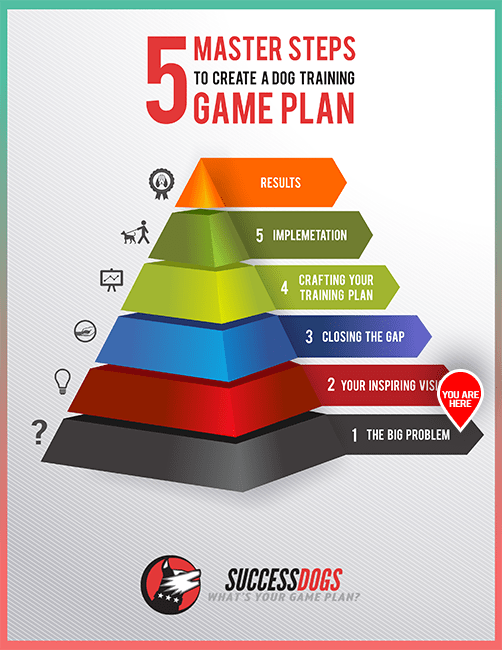
The first thing that you need to do is identify what the big problem is. And by big problem, I mean whatever you want to solve with your dog.
Maybe it’s peeing on the carpet, not coming when called, or pulling on the leash. Whatever it is, you have to be clear about solving one specific problem.
Oftentimes when a dog owner asks me to help train their dog, the owner will tell me how their dog has many problems and will want me to create a training plan to solve all of them. And I have to tell the owner that it’s better to focus on solving one problem at a time than to try tackling four or five problems and end up becoming overwhelmed and frustrated.
So right now, think about one specific problem with your dog, and dedicate the remainder of this guide to solving it.
To help you understand how I go about creating a training game plan, I will go through the process as if I’m working with a dog that pulls on the leash. I recently worked with a dog that had this problem, so it’s fresh in my mind.
YOUR ASSIGNMENT: Write down one problem with your dog that you are dedicated to solving.
MASTER STEP 2: YOUR INSPIRING VISION
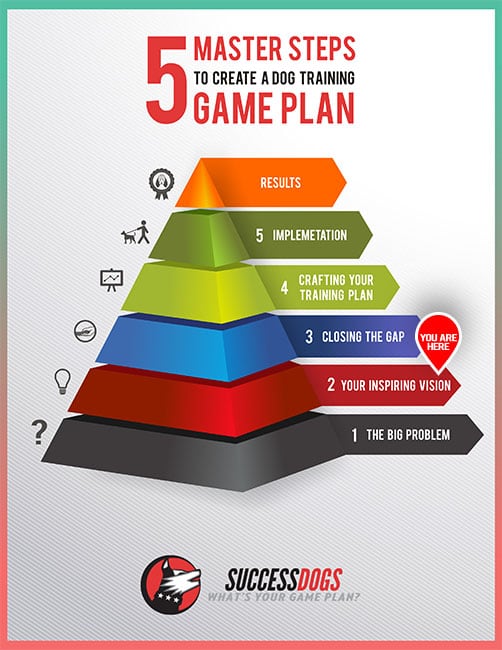
Once you know exactly which problem you want to change, it’s time to move on to the next step, which is to create an inspiring vision.
This is what you want your dog to become, or how you would like it to be if your dog didn’t have the particular problem. Really think about this. The clearer you are about what it is that you want, the more likely you will be to attain it.
It’s not enough to go from “my dog is digging in the backyard” to “I want my dog to not dig in the backyard.” That isn’t going to motivate anybody, and to be totally honest with you, you’re going to need to take some action to solve your dog’s problem. There’s just no way around that.
You need to create an inspiring vision so you are pulled forward toward change rather than having to force yourself to take action.
I’ve been to dozens of self-help seminars, including all of Tony Robbins’ seminars, and what they all have in common is that you have to create in your mind a clear picture of what you want—something that emotionally inspires you.
So think about your vision and add emotion to it. How would you feel if your dog never had this problem again? How much stress would that eliminate? How much happier would you be? And how would your relationship with your dog grow as a result? Would you feel closer to your dog? Would you enjoy your dog’s company more?
Step into this vision and feel like it’s happening today. How do you feel?
ASSIGNMENT: Write down in your own words a vision of your dog that inspires you.
MASTER STEP 3: CLOSING THE GAP
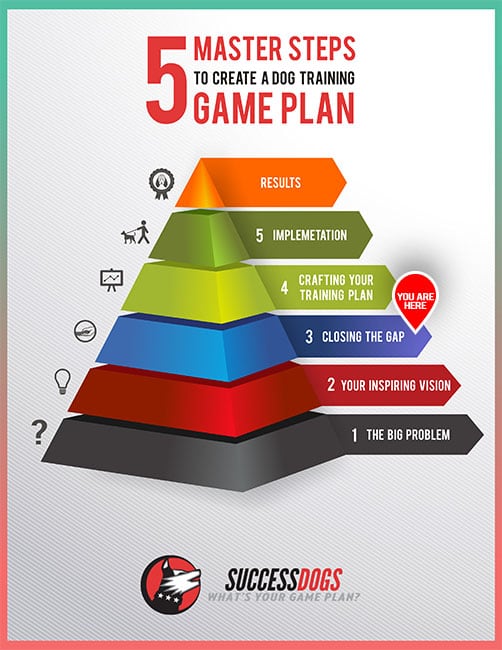
When you think about the problem you have with your dog and your inspiring vision, there’s an obvious gap between the two. This stage is about figuring out ways to close this gap.
First, let’s analyze the problem in a little bit more depth. The more you know about it, the easier it’s going to be to craft your training game plan.
Ask yourself the following three questions:
#1: When does this problem occur?
#2: What triggers the problem to occur?
#3: Is there more than one trigger?
Your answers to these questions will give you a great deal of clarity. For example, when I answered them for a dog that was pulling on the leash, I figured out that she would pull mainly when she wanted to get to something, whether that was a leaf blowing, grass on the ground, or an exciting smell coming from an object. She didn’t really “pull all the time,” as her owner described the behavior to me.
From those answers, you should be able to come up with a list of one or two focus areas that you need to work on with your dog.
For example, if the dog lunges at a blowing leaf, I need to develop the dog’s self-control skills—that’s one focus area. And if the dog strains at the end of the leash, I need to build that dog’s attention skills—that’s a second focus area.
You always want to think in terms of improving your dog’s particular skill or ability. This will keep you from falling into the punishment trap, in which you punish your dog for not doing what you want.
ASSIGNMENT: Write down one or two focus areas that you’ll commit to improving.
MASTER STEP 4: CRAFTING YOUR TRAINING PLAN
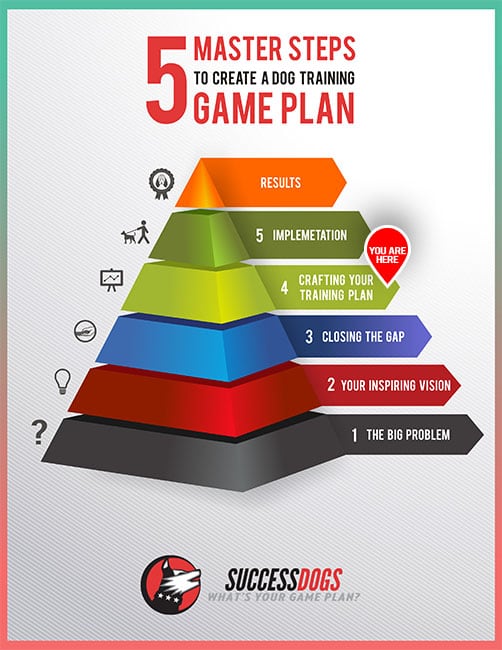
Do you see the magic in what we’ve done so far? Instead of having one giant and overwhelming problem that you’re trying to solve, you can instead focus solely on one or two areas. This completely changes the way that you’re going to go about training.
In this stage, the objective is to create action steps that you can implement with your dog on a daily basis. You’ll need to take each of your focus areas and brainstorm ways to improve them, while making sure that they are both achievable and incremental.
What I mean is that you must always set your dog up for success, and each step should build upon the previous one so that the focus area gradually improves.
To give you an example, here are my lists of action items for both areas of focus:
Self-Control:
- Ignore a dog treat in my hand (indoors)
- Ignore a dog treat on the floor (indoors)
- Ignore human food on the table (indoors)
- Ignore human food on the floor (indoors)
- Ignore a whole bag of popcorn on the floor (indoors)
- Ignore a rock on the ground (outside)
- Ignore a paper cup on the ground (outside)
- Ignore an opened bag of chips on the ground (outside)
- Ignore a leaf on the ground (outside)
- Ignore a blowing leaf on the ground (outside)
Attention:
- Touch my hand (indoors)
- Touch my hand at my side (indoors)
- Touch my hand while walking (indoors)
- Touch my hand while turning directions (indoors)
- Touch my hand while ignoring a dog treat on the floor (indoors)
- Touch my hand (outside)
- Touch my hand while walking (outside)
- Touch my hand while walking on the grass (outside)
- Touch my hand while ignoring a paper cup on the ground (outside)
- Touch my hand while ignoring a blowing leaf (outside)
As you can see, some of these action items from both focus areas overlap. And that’s okay, but can you see how the focus is on developing the skill rather than on stopping the problem?
ASSIGNMENT: Write at least ten action items for each focus area. Don’t try to make this perfect—just brainstorm, and you can always revise the list later.
MASTER STEP 5: IMPLEMENTATION
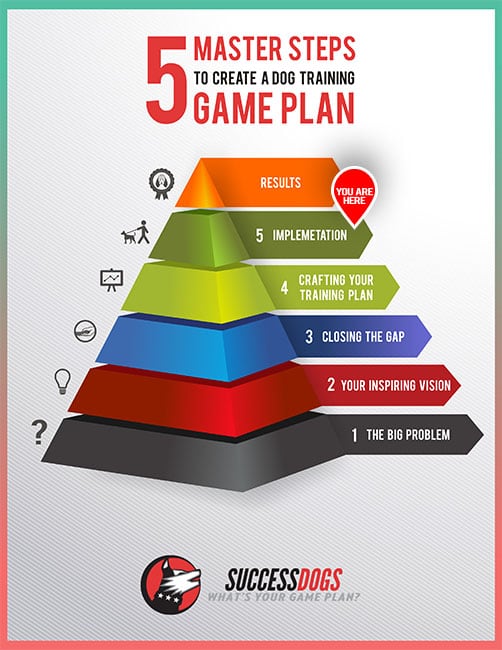
Once you’ve created your training plan, the only thing left to do is to implement it with your dog.
From my experience in training dogs, there’s nothing like the power of scheduling. I know that this isn’t attractive, but if you write down on your calendar which days you’re committed to training your dog and for how long, you’ll be much more likely to follow through.
I know that you’re busy. You work long hours, and you really don’t feel like training your dog after a long and busy day at work. I get it. But what if you only committed to implementing this training plan for a week, two weeks, or a month? That’s a very small fraction of your dog’s life and could make a huge difference.
Do you remember your inspiring vision? This is what’s going to motivate you to take action and take the time to train your dog.
How often and how long you should train your dog is totally dependent on what the problem is and how much time you have. I highly recommend keeping your training sessions short (about fifteen to twenty minutes)—shorter if you are working on an intricate behavior.
The minimum that you should train your dog is once a day. You won’t get the results that you want if you skip days or train your dog only once a week. And if you want even faster results, you can train several times per day, say in the morning, afternoon, and evening.
ASSIGNMENT: Schedule your next three training sessions with your dog. They can happen all during one day or be spread out over three days.
RESULTS
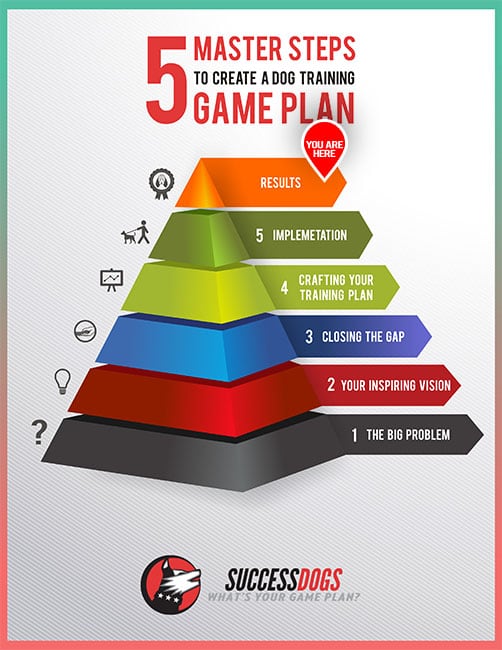
Once you implement the training plan with your dog, you will notice results. And if these results are not exactly what you’re looking for, that’s okay. You may have to change something in your training plan.
This is exactly what I do with every dog that I work with. First, I implement the training plan that I created. If the action item inside the training plan doesn’t work, I simply go back to the drawing board and make a change. I then try again, and do this over and over until I succeed.
This is the magic formula for dog training success.
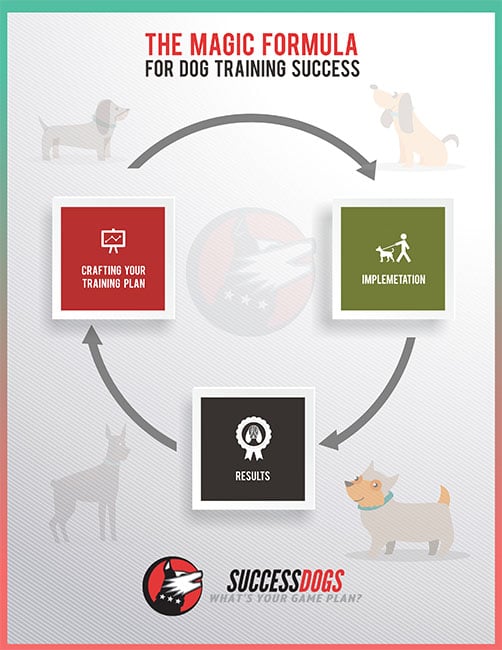
CONCLUSION
This is the exact process that I use to train any dog, regardless of the problem. And now, you can use it with your own dog.
If you would like to see exactly how I worked with the dog that pulled on the leash, I recorded all of my training sessions and created a course called The Walk in Harmony Game Plan. Inside, you can see exactly which skills I developed and how, as well as all of the different action items that I implemented to get what her owner wanted, a dog that walked nicely on a loose leash.
Free Dog Training eBook – The Power of Positive Reinforcements
Have you ever wanted a dog so behaved and well-trained that people compliment on his awesomeness?
Well, this is exactly what happened to me when I started training my dog with Positive Reinforcements (this is a fancy name for reward-based, force-free training.)
Friends and family started to compliment me on how well-behaved my dog was, and how much they loved her because of all the amazing tricks she could now do. And once I taught my dog how to play chess (yes, I taught her that!), I just knew that this training method was the most powerful thing on earth.
And this is why I wrote this eBook that I’m giving away for free – the Power of Positive Reinforcements.
I want you and all dog owners around the world to experience this way of training. Because it simply works – some of the world’s greatest dogs were trained using this method. And best of all, dogs absolutely LOVE it! (And it even brings you closer to your dog!)
You’ll discover inside the eBook…
- Your dog’s deepest desire (page 23) – Without it, you will never be able to effectively train your dog to do anything. (Think of it like being paid for a job well done – you have to figure out what motivates your dog so you can get him to do … what you want him to do!)
- Training your dog to come (page 26) – This is the MOST important skill you can ever teach your dog … think about it, what would happen if your dog got loose near a busy street? You need a way to get your dog to come back to you!
- Walking on a loose leash (page 34) – It is a well-known fact that lack of exercise leads to destructive behaviors. And the easiest way to exercise your dog is to WALK your dog … but who wants to go on a walk while getting dragged down the road?
- Avoiding food possessiveness (page 39) – Perhaps you’ve already noticed that your dog doesn’t like having you near his food bowl … but did you know that there’s something you can do about it? In fact, you can even get your dog to LOVE you being near it.
- Grooming your dog (page 43) – Brushing and taking care of your dog’s coat is extremely important – but how many dogs hate it? The simple exercises in this section will help solve that problem forever!
- Obedience training (page 50) – Want your dog to listen to your “Sit”, “Down” or “Stand” command? Simply follow the step-by-step instruction in this chapter and you’ll get your very own Lassie!
- Teaching your dog tricks (page 58) – What would the world be without dog tricks? They entertain us and dogs absolutely LOVE doing them … so why not take a few minutes of your day and teach your dog some of the best dog tricks?
And this is just a small sample of what is inside the eBook. Again, I wrote this eBook because I wanted to spread the word about Positive Reinforcement training and how much of a difference it can make in your dog’s life.

(a $47 value yours free!)[/optin_box_field][optin_box_field name=”paragraph”]PHA+RW50ZXIgeW91ciBpbmZvcm1hdGlvbiBiZWxvdyB0byBjbGFpbSB5b3VyIGZyZWUgY29weS48L3A+Cg==[/optin_box_field][optin_box_field name=”privacy”]Your information will never be shared with anyone.[/optin_box_field][optin_box_field name=”top_color”]undefined[/optin_box_field][optin_box_button type=”0″ button_below=”Y”]Send Me The eBook![/optin_box_button] [/optin_box]
If you enjoyed reading this eBook, please share it with your friends by clicking the Facebook Like button located on the left hand side of the page.
The more we share this eBook, the more people will be able to train their dog using positive, force-free and reward-based training methods!

